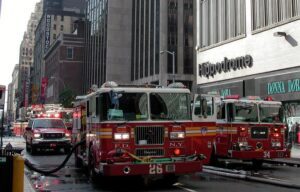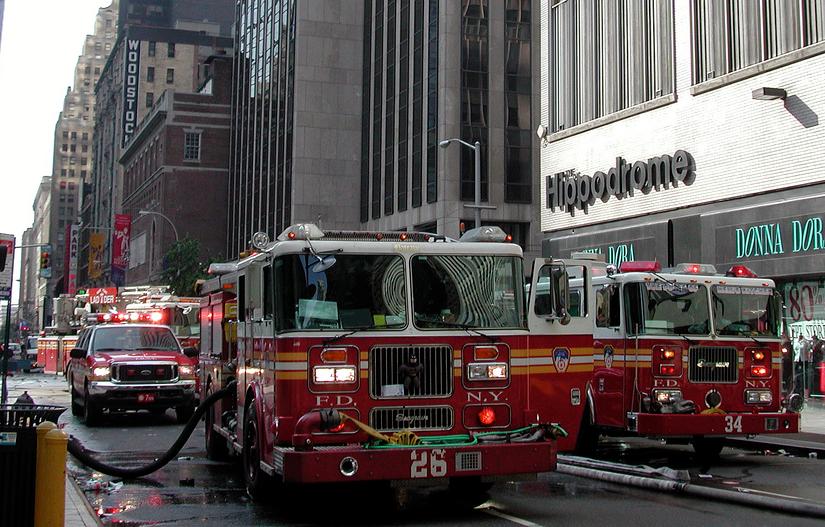
cisc1970, CC BY 2.0
New York City Fire Department (FDNY) on Public Safety Drone Operations in Cities: From the Field National Public Security UAS Conference.
Continue reading below or listen to:
Michael Wall, Michael Leo, and Kevin O’Malley are members of the FDNY, one of the world’s most prominent public safety divisions. Operating in an urban environment presents challenges, but FDNY supports responders from the air. In a presentation at the National Public Safety UAS Conference, the team discussed building a drone program and lessons learned from flying in New York.
If you want to become an FDNY drone pilot…
Captain Michael Leo is Director of FDNY Special Operations Command Robotics Division, and Mike Wall and Kevin O’Malley are veteran FDNY firefighters and UAS pilots. The FDNY drone program has reached maturity and the team is currently identifying ideal profiles for new candidates. This is the profile that ensures the drone is used most effectively. They consider every candidate individually, but generally they’re looking for experienced firefighters, not experienced drone pilots. “We choose people based on their personality and interests, not their experience,” says Mike Wall. “Skills can be learned”
“We’re only 14 people, so we need someone who can blend in well with the crew,” points out Kevin O’Malley.
They also established the ideal time for firefighters to enter the program. , they know how the department works, they know what’s expected of them, and they know that person will be around for another 10-15 years.”
Developing Training Programs: What “Micro-Training” Means in First Response
The team considers Part 107 certification a prerequisite. This is the first thing prospective members can do to show interest. “Part 107 shows that you invested in yourself,” he says Kevin O’Malley. “But it’s just hard training.”
FDNY pilots then undergo a five-day training course. This training course begins with basic his UAS knowledge and capability assessment using his NIST standards, and progresses through mission planning, indoor flight, proximity flight, live-fire scenarios, thermal imaging, and more. These training days are designed to build the skills FDNY needs in its unique environment.
“In general, we don’t do a lot of indoor flying,” said Mike Wall. “But in New York we are dealing with GPS multipath, blocked skies, wind, etc. There are so many issues that can lead to flyaways. It helps and you can take over if you need to.”
Most of the training takes place in public parks. It’s not just for open space, it’s also for providing opportunities for interaction with the community. “We really encourage people to come and talk to us,” says Mike Wall.
After a five-day training course, new pilots, under the supervision of an experienced member, take over the role of pilot and follow the experienced flyer until they are ready to reverse the role.
The concept of micro-training: future goals
FDNY is a metropolitan department. They are experts in urban operations, from Manhattan’s wind tunnels to traffic handling. NYC also has more than 560 miles of coastline, making maritime operations a key focus. Ideally, he could offload the burden of basic training to a third party so he could focus on “micro-training” and develop the skills he needed for his day-to-day work in NYC, says Mike Wall. increase.
Micro-training can be a model that leverages the skill sets of departments across the country. By sharing standards, departments can develop training programs relevant to their experience. Whether it’s working in a specific terrain or for a specific purpose like dealing with rapid currents in Hawaii or handling hazardous materials.
“By combining the private sector with internal training that focuses on site-specific UAS operations, such as operating in an urban environment, you get the best of both worlds,” says Mike Wall. “You can stay in your lane and focus on the training you need to develop subject matter experts. It’s a drill that squeezes the
“[Micro training] Help standardize specific UAS operations. If you’re good at marine operations, help develop those standards. If you are good at operating in urban areas, work on it. It also helps build a foundation for regional training facilities, creating a plug-and-play model. The same person can be trained in the same way. ”
“If we all work according to standards, we all work the same way and work together seamlessly,” points out Kevin O’Malley.
Challenges and changes
As a department, Wall said, the FDNY drone team is always working to overcome complacency. “You can get a false sense of security for a long time without an accident,” he says. “It gives me confidence that I’m doing everything right.” Wall points out that procedures need to be reviewed constantly to make sure the department is working safely and efficiently. increase.
Manpower is always a challenge and never enough. Even FDNY can have a hard time getting people where they need to be. In the future, FDNY believes it may have drone stations on boats during the summer. Or the whole city.
Finally, Mike Wall notes that self-certification is an issue for departments to consider carefully. “I hate it,” he says. “Self-certification leaves the department facing a number of liability issues. In the event of a UAS incident, we may need to prove that we not only meet but exceed FAA standards. No, but it can be very difficult.”
The FDNY drone program was conceived in 2014 when civilians flying Phantoms appeared on fire and provided footage to responders. Operating a drone program in NYC presents unique challenges, but FDNY has worked through the regulatory, political and technological challenges to make it happen. “When we first started, we told people that the drone had arrived and told them to take the toys out of it,” says Mike Wall. “Okay, ‘Where’s my drone?’ We just started flying. When it delivered Data, it was Data who sold the members by drone. ”
read more:
Miriam McNabb, editor-in-chief of DRONELIFE and CEO of professional drone services marketplace JobForDrones, is a fascinating observer of the emerging drone industry and drone regulatory environment. With her 3,000+ articles focused on the commercial drone space, Miriam is an international speaker and recognized figure in the industry. Miriam has a degree from the University of Chicago and high tech she has over 20 years of experience in sales and marketing new technologies.
For drone industry consulting or writing, please email Miriam.
twitter:@spaldingbarker
Subscribe to Drone Life here.
